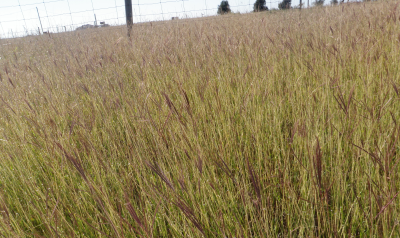Bothriochloa ischaemum var. songarica
King Ranch Bluestem
Synonym(s): Amphilophis ischaemum, Andropogon ischaemum, Dichanthium ischaemum
Family: Poaceae
Duration and Habit: Perennial Grass/ Graminoid

Photographer: Ashley R Morgan
Source: South Texas RSLH survey for TISI
Description
The King Ranch Bluestem is a bunchgrass that grows in tufts with erect or spreading culms 18-48 inches tall. Stems turn a straw color when mature. Leaves are thicker near the collar and the upper surface is covered with long, silky hairs. The stems are naked at the top. Each stem produces a loose, terminal seed head that is usually purplish. On several primary branches spikelets can be found, with a reddish-purple color, whether the spikelets are fertile or sessile.
Ecological Threat: Bothriochloa ischaemum has been observed to diminish grassland bird diversity and abundance, by reducing insect diversity. In addition, another study has shown that habitats dominated by Bothriochloa ischaemum also produce a less species-rich rodent fauna that habitats with native grasses. The King Ranch Bluestem variety could logically have the same impact on ecosystems throughout Texas and Oklahoma grasslands. These are just a few examples of how this dominating grass can create monotypic habitats which in turn reduce the diversity of insects, birds and rodents; which can further devastate natural ecosystems. Not only is the grass a threat but so is the insect that utilizes the King Ranch Bluestem as a host plant, the red streaked leafhopper. The red streaked leafhopper has been observed to carry a phyoplasma to sugarcane in Thailand, creating crop losses of up to 100% in some areas. The threat of the King Ranch Bluestem is the fact it can severely decrease animal diversity but also carry along the red streaked leafhopper (RSLH) which could potentially decimate sugarcane crops in the United States.
For more information on the RSLH click here
Biology & Spread: King Ranch Bluestem blooms with yellow flowers in the early summer, which for more tropical latitudes could start as early as April. This species is winter hardy and can be found from Russia to Northern India. Also, it is more resilient than other Bothriochloa species when facing human disturbance. This is why King Ranch Bluestem is found on highway medians and roadside ditches all throughout central, southern and eastern Texas.
History: In the native lands, Bothriochloa ischaemum is thought to be an excellent grass for soil and water conservation. The resilience of Bothriochloa ischaemum encouraged the intentional introduction of Old World Bluestems in the late 1800s and early 1900s; because of their high forage quality, grazing tolerance and rapid growth or establishment. The specific King Ranch bluestem, Bothriochloa ischaemum var. songarica, was intentionally created on the King Ranch as an ideal foraging grass for grazing animals. However, since plants cannot be contained within open areas, the grass accidentally spread beyond the King Ranch and now inhabits over half of Texas.
U.S. Habitat: With a winter hardiness and preference for warmer temperatures this grass could spread to other coastal and great plain United States.
Distribution
Native Origin: Atlantic Coasts of Europe to Pacific Shores of Asia
U.S. Present: Oklahoma and Texas
Management
Minimal management options are available for the eradication of King Ranch bluestem; timely mowing, controlled-burning and herbicide application can suppress this species. However, the King Ranch bluestem is present on almost every roadside from Harlingen to Jasper, Texas; making eradication or even management of this grass nearly impossible. On an individual level, one can keep an eye out on their property or near their neighborhoods and mow the grasses accordingly or apply herbicide to your property. Eradicating state-wide will be more of challenge and may never occur.
Text References
Celarier, S.P. and J.R. Harlan (1955). Studies on Old World bluestems. Oklahoma Agricultural Experiment Station Technical Bulletin T-58.
Harlan, Jack R. (1963). Natural Introgression between Bothriochloa ischaemum and B. intermedia in West Pakistan Botanical Gazette 124(4): 294-300.
Hickman, K. R., Farley, G. H., Channell, R., & Steier, J. E. (2006). Effects of old world bluestem (Bothriochloa ischaemum) on food availability and avian community composition within the mixed-grass prairie. The Southwestern Naturalist, 51(4), 524-530.
Sammon, J. C., & Wilkins, K. T. (2005). Effects of an invasive grass (Bothriochloa ischaemum) on a grassland rodent community. Texas Journal of Science, 57(4), 371.
XU, Q. F., & DONG, K. H. (2004). The dominant species of shrub grassland Bothriochloa ischaemum [J]. Grassland and Turf, 3, 006.
Internet Sources
 Texas Invasive Species Institute
Texas Invasive Species Institute